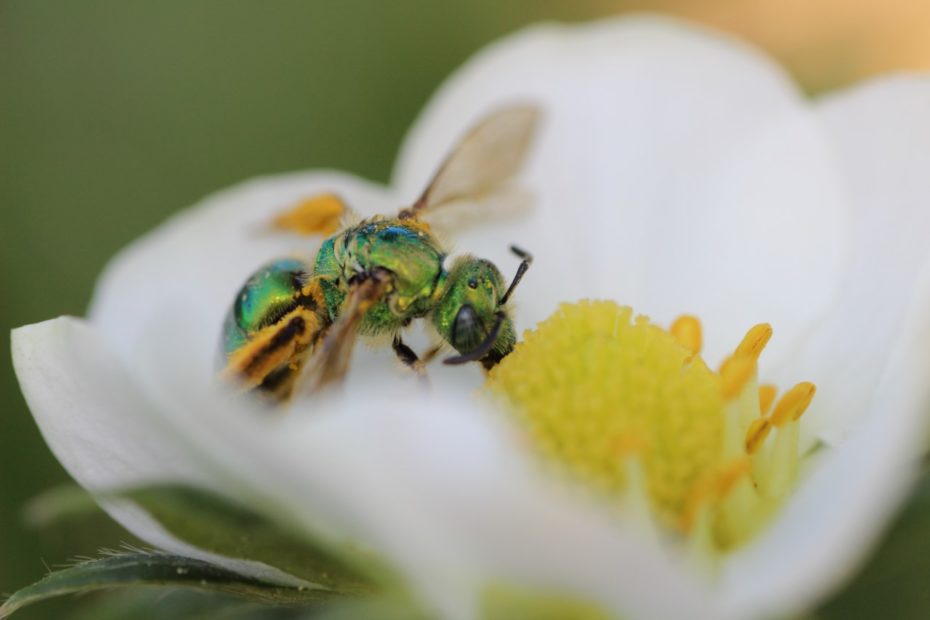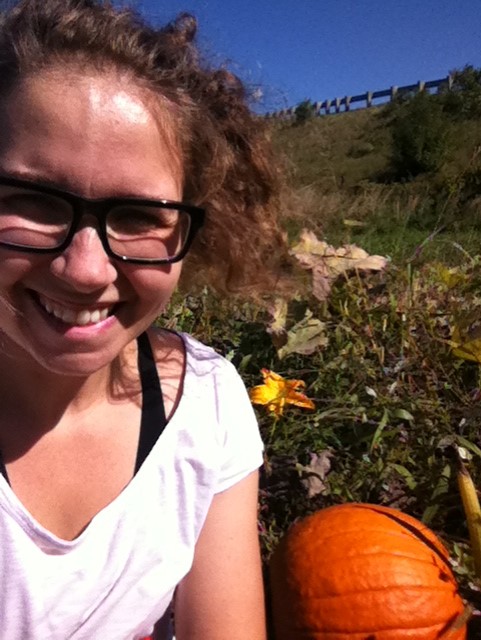
McGill entomology researcher and PhD candidate Gail MacInnis says that when comparing pollination efficiency between wild bees native to Canada and the more numerous honey bees, there is no contest. Wild bees win, wings down.
“For strawberry, we found that honey bees often visit flowers just for the nectar, they’re not actively collecting the pollen,” said MacInnis, whose research has focused on the pollination efficiency, mostly on strawberry crops. “So, they don’t transport (pollen) from flower to flower, which is what the flower needs to produce a fruit… Honey bees are very neat, they wet the pollen with a little bit of nectar, put it in a little ball in their leg and take it back to the hive to feed their babies. Wild species are messier, they carry the pollen dry all over their bodies, so it tends to deposit on the flowers more.”

MacInnis presented the findings of her research earlier this week, at the 46th Apimondia International Apicultural Congress in Montreal, a major industry conference that attracted 6,000 participants from around the world, in recognition of the key role bees play in global food production sustainability. The Congress wraps up tomorrow.
Pierre Giovenazzo, president of Apimondia 2019 and a Professor of Biology at Laval University, said that only about 200 presentations, including MacInnis’, had been retained out of 980 abstracts worldwide submitted to a blue-ribbon selection committee composed of 20 specialists and a world-renowned researcher in apiculture. MacInnis is the only Canadian graduate student speaking in the session on non-Apis crop pollination.
In discussing work at the University, MacInnis praised McGill’s Horticulture Research Centre at the Macdonald Campus. “I can’t say enough good things about them,” she said. “I wouldn’t have got everything done in my research without that resource. And they do so much for the wild species. They never spray during bloom, they use bio-control practice whenever possible. The abundance of wild species at the Horticulture centre made it much easier to collect the data I needed.”
The McGill Apiculture Club and the Lyman Entomological Museum and Research Laboratory, one of the biggest insect museums in North America, were also invaluable resources for her work.
Honey bees not so sweet
MacInnis is now hoping to correct the widespread conviction that urban beekeeping, a growing trend in Montreal, is helping to save bees from extinction. It isn’t.
Urban bee keepers raise honey bees, which are not an endangered species, to produce honey. The problem in urban areas, MacInnis said, is that honey bees, which were imported from Europe, compete with many of our native Canadian bee species for floral resources and sometimes do not pollinate certain plants as well as other wild bee species.
Most of these wild bees live solitary lives underground, not in hives managed by humans. Consequently, much of their natural habitat has been ploughed, tilled, paved over, cut down or otherwise disturbed. Honey bees often get to flowers first and use up all the pollen in the nectar, leaving nothing for the wild species that can pollinate some plants better than honey bees.
Declining bee populations
Urban beekeepers, including multiple-hive owners and developers, have flooded Montreal with about 600 hives since 2012, each of which can have between 50,000 and 100,000 bees. That’s placed a major burden on wild species, which “are solitary,” said MacInnis. “Often, it’s one queen living in the ground, producing between five and 10 babies a year.”
In large-scale monoculture operations – large strawberry grow-ops, for instance – “there’s just not enough wild species to do the job” of pollinating, so honey bees are imported and moved from crop to crop.
Media reports tend to focus on the effects of pesticides on bees, MacInnis said. But urban beekeeping is a separate issue that is often conflated with crop pollination problems. Both wild bees and honey bees are indeed under stress, but bringing honey bees into urban areas, does nothing to remedy the problem facing wild bees. The question is whether the roughly 150 wild bee species living in Montreal are disappearing faster and in greater numbers due to the presence of honey bees.
“We don’t know how many wild species we’re losing because they are very hard to monitor, especially small species. With honey bees, it’s easy, they’re managed. I am much more concerned with what’s happening to wild bee species – and everyone should be.”
Disrupting pollinator networks
MacInnis swats away the arguments that say no research has found that honey bees have a negative effect on wild species.
Not true, she said, citing new studies “showing an overabundance of honey bees can affect our native pollinating species, causing them to decline.”
She cites a recent study in Paris, which coincidentally also had 600 new urban hives, as an example. “There are studies that have found that the increase in honey bees is reducing the visitation rates to flowers by wild bees and disrupting plant-pollinator networks. So, we’re potentially losing wild species, especially the species competing for similar flowers.”
MacInnis is launching a proper study for Montreal starting next summer to look at how saturating the city with honey bees is affecting wild species. “We’re certainly not saying ‘no honey bees.’ We want to make sure we can have them in the city,” she said. “But we just want to find out what’s a safe number of honey bees that doesn’t affect the ecosystem and all our wild species.”
The task at hand for now is to set the record straight in popular thinking. MacInnis is surprised how the honey bee has become a symbol for conservation and biodiversity, calling it “weird.”
“It’s an introduced species,” she said. “Diversity means more than one species. If you increase the abundance of one species, you’re doing nothing for biodiversity. You may even be reducing bee diversity by outcompeting the native species.”
